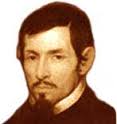Antonio Mira de Amescua
Antonio Mira de Amescua (1578? – 1636?), Spanish dramatist, was born at Guadix (Granada) about 1578. He is said, but doubtfully, to have been the illegitimate son of one Juana Perez. He took orders, obtained a canonry at Guadix, and settled at Madrid early in the 17th century. He is mentioned as a prominent dramatist in Rojas Villandrandos Loa (1603), which was written several years before it was published. In 1610, being then arch-dean of Guadix, he accompanied the count de Lemos to Naples, and on his return to Spain was appointed (1619) chaplain to the Cardinale-Infante Ferdinand of Austria; he is referred to as still alive in Montalbán's Para todos (1632), and he collaborated with Montalbán and Calderón in Polifemo y Circe, printed in 1634. The date of his death is not known.[1]

Mira de Amescua's plays are dispersed in various printed collections, and the absence of a satisfactory edition has prevented, his due recognition. He has an evenness of execution which indicates an artistic conscience uncommon in Spanish playwrights; he resisted the temptation to write too much, and he unites a virile dignity of expression to impressive conception of character.[1]
Two of his plays—La adversa fortuna de Don Bernardo de Cabrera and El ejemplo mayor de la desdicha—are respectively the sources of Rotrou's Don Bernardo de la Cabrère and Belisaire; Moreto's Caer para levantar is simply a recast of Mira's El Esclavo del demonio, a celebrated drama which clearly influenced Calderón when composing La Devoción de la cruz; and there is manifestly a close relation between Mira's La Rueda de la fortuna on the one hand and Corneille's Héraclius and Calderón's En esta vida todo es verdad y todo es mentira. A few of Mira de Amescua's plays are reprinted in the Biblioteca de autores españoles, vol. xlv.[1]
References
-

External links
- Works by or about Antonio Mira de Amescua at Internet Archive
- Works by Antonio Mira de Amescua at LibriVox (public domain audiobooks)
